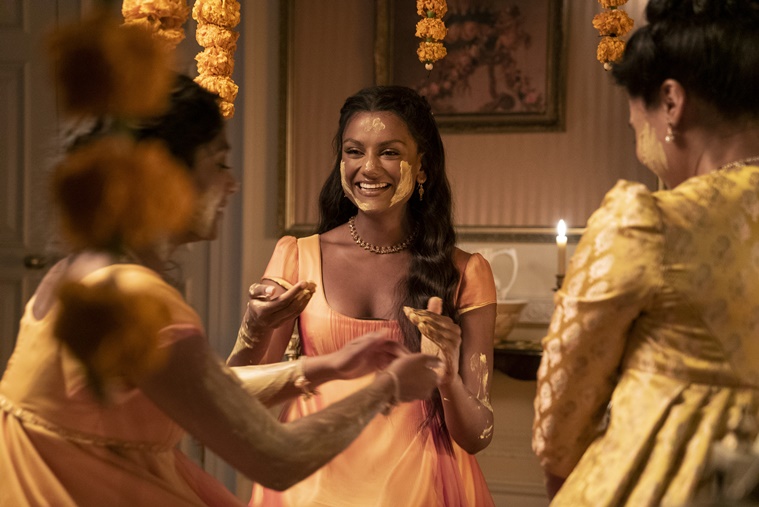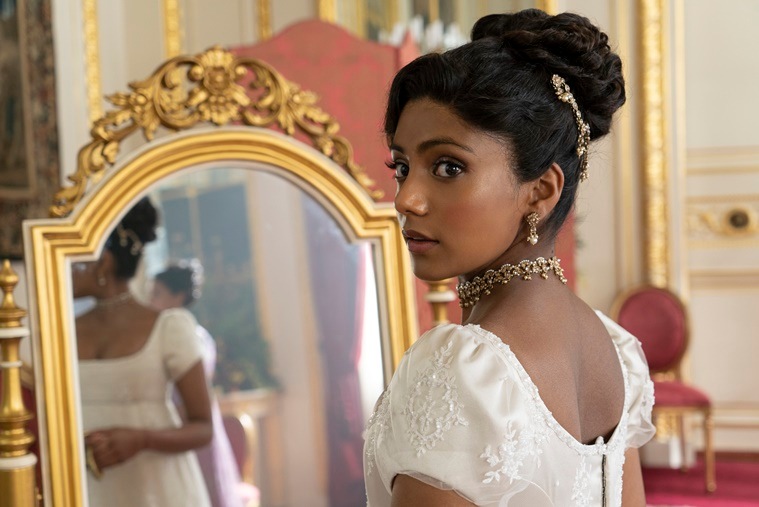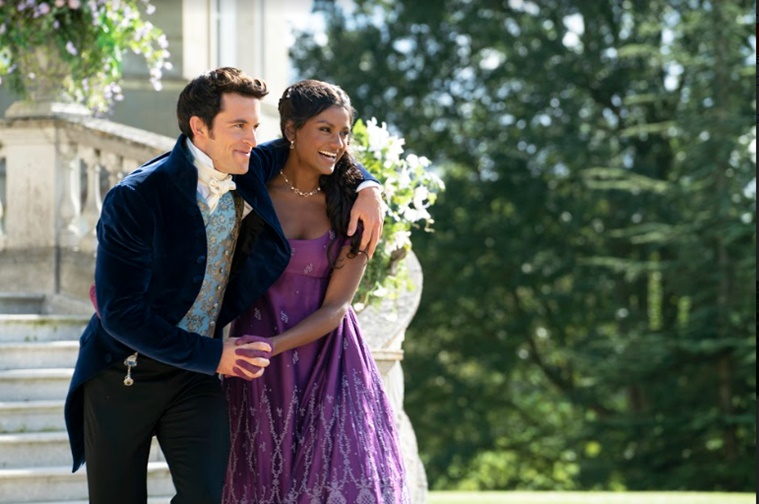Latest Comment
Post Comment
Read Comments
 A still from the web-series Bridgerton Season 2. (Credit: Liam Daniel/Netflix)
A still from the web-series Bridgerton Season 2. (Credit: Liam Daniel/Netflix)There’s a perfectly admissible explanation for the Kate Sharma-Appa-Bon-Didi problem. Perhaps, Kate’s mother was Tamil, and “Appa” is Kate’s way of honouring her roots. Perhaps, she calls Edwina “bon” (the Bengali “bone” means younger sister) as an inside joke between the two. Edwina is fluent in Marathi, which is understandable as the Sharmas are from Bombay. Perhaps, their father, a clerk, was smart to learn the local language (Gujarati would have been of interest, too). Any number of conjectures could untangle this caricature of an Indian family that Bridgerton served this season, drawing flak from Indian audiences for its wilful ignorance and poor understanding of India’s complexities.
Paromita Vohra, filmmaker and founder of Agents of Ishq, a multimedia platform on sex and desire, says, it is indeed perplexing that people just can’t seem to get the textures of Indian identity right. She says, “In Bridgerton, one takes nothing seriously, to be honest, not the exaggerated panting of the main leads and not the hilarious masala chai. Rather, like older Bollywood, a certain preposterousness comes with the territory. And yet, it is definitely part of an entire history of gadbad representation of Indian characters, whether it is Mangal Pandey being denoted as Bengali, or Bon and Appa being words of address in the same family.”
 A still from the web-series Bridgerton Season 2. (Credit: Liam Daniel/Netflix)
A still from the web-series Bridgerton Season 2. (Credit: Liam Daniel/Netflix)
Season 2 is currently Netflix’s most-watched English-language series with 627.11 million hours of viewership in their first 28 days on the OTT, beating Season 1 by 1.62 million hours. The second season focuses on a match for the eldest Bridgerton, Anthony — a viscount and the man of the house. His sights are set on Edwina as a suitable match even as his heart aches for Kate. The series is set in 1813-14, in a fantasy version of the Regency era, where the reigning queen is black, the East India Company (EIC) doesn’t exist, and colonialism, like racism, is unheard of. Tea, spices, and the sheer cotton shirt that sticks to Anthony’s chest (a role reversal of Bollywood’s obsession with wet-sari scenes) have been stripped of their dark connotations and somehow landed in Bridgerton despite the absence of colonialism. Kate dismisses “this pitiful excuse for tea the English so adore” and makes her own chai with spices — a move that has won brownie points from Indian audiences for the show. In reality, tea wasn’t a popular beverage among Indians until a century later, as Krish Ashok, author of Masala Lab: The Science of Indian Cooking (2020), confirms. A majority of the Indian population did not have a morning or evening beverage. In some parts, a carb-heavy rice milk was consumed by those who performed hard labour.
Ashok says, “The only people drinking tea in the early 19th century were British officials, some indigenous people in Assam and elite Indians who picked up the habit from the colonial masters.” In 1903, the government’s tea board (now Tea Board India) started heavily marketing the brew in India. The Indian response was to initially reject tea’s subtle flavours and infuse it with ginger and cardamom, giving rise to masala chai’s popularity.
 A still from the web-series Bridgerton Season 2. (Credit: Liam Daniel/Netflix)
A still from the web-series Bridgerton Season 2. (Credit: Liam Daniel/Netflix)
Bridgerton also dismisses tea’s controversial links with opium. In the early 19th century, the only teas available were from China, supplied to Britain in exchange for opium from India — a trade that would result in the infamous Opium Wars in the mid-19th century.
How far can storytellers go in their attempts to revise history? Shashi Tharoor, Lok Sabha MP and author of Inglorious Empire: What the British did to India (2017), says that while he hasn’t watched Bridgerton, he has, for long, had a problem with the “gauzy romanticism” with which the British like to view the colonial era. He says, “It wasn’t all tea parties and croquet on the lawn… Colonialism rested on the cruel edifice of racism and exploitation, and to gloss over that is rank dishonesty… Colour was an indistinguishable factor governing the way people were perceived and treated, well into the middle of the twentieth century.”
Perhaps, Kate invents masala tea in this fantasy Bridgerton. And while she is welcomed here, historically, things were not easy for Indian women in elite British circles. Arup K Chatterjee, professor at OP Jindal Global University and author of Indians in London: From the Birth of the East India Company to Independent India (2021), says that Indian wives, begums and mistresses who travelled with Europeans to London led relatively unfortunate lives compared to the men. He says, “Indian or Indian-origin women in Britain were unremittingly yoked to their racial identity and their ability to imbibe ‘Englishness’ by virtue of mimicry of English manners and contracting expedient romantic alliances, preferably with EIC officials and soldiers.” These didn’t always guarantee successful integration.
Chatterjee cites the example of Halima Begum of Awadh, who travelled with a French mercenary soldier General Benoît de Boigne in 1796 and began living in London, rechristened as Helene Benoit or Bennett. Her husband left her for the daughter of an exiled French ambassador. Eventually, she retired to Sussex, where she lived the rest of her life on a small pension arranged by friends. She carried on with a few vestiges of her bygone begumhood, one of them being the habit of smoking hookahs. Yet, she was generally regarded as a pious Catholic woman — having converted to her husband’s religion before marriage. It has been speculated that the Romantic poet Percy Bysshe Shelley saw her roaming about St Leonard’s Forest as a “Black Princess”.
 A still from the web-series Bridgerton Season 2. (Credit: Liam Daniel/Netflix)
A still from the web-series Bridgerton Season 2. (Credit: Liam Daniel/Netflix)
Bridgerton 2 deftly escapes the timeworn tropes of an exotic, mysterious Orient. By casting two British-Tamil actors — Simone Ashley and Charithra Chandran — in leading roles, Bridgerton has done a better job than mainstream Tamil cinema, where dark Dravidian female actors are mostly seen in roles signifying a lower-economic class, an oppressed caste or rural India.
If history has to be sacrificed at the altar of fantasy, such rewards could be worthwhile. Hamilton, Lin-Manuel Miranda’s Pulitzer-winning hip-hop musical that premiered in 2015, reimagined America’s Founding Fathers as people of colour through a diverse cast. Productions like these allow Bipoc (Black, indigenous, and people of colour) actors to participate in period settings that are otherwise solely associated with slavery, racism and colonialism. There may not have been space for the Sharma sisters in Regency England, but there certainly is for Ashley and Chandran in roles that don’t portray them as oppressed in a historical setting that was predominantly White and upper class.
Vohra believes filmmakers can go as far as they want when it comes to rethinking historical facts so long as the work has artistic and ethical integrity, allowing viewers to follow the filmmakers’ logic, whether it’s factually rooted, an imaginative creative or political gesture.
Recent criticisms of Bridgerton have attacked its complacent acceptance of the dowry system and its use of an upper-caste surname. Sure, there is a lot to hate about it, but what is Bridgerton, if not desire persevering? The series seemingly upholds courtship, but has lovers unite despite strict moral codes. It should appeal to India, where love matches are regulated with violence, murder and rioting. “Just keep looking at me. No one else matters,” we hear Anthony tell Kate.
Besides, if we can accept a Malti Marie Chopra Jonas, why not the fictional Sharma family mash-up? If we allow ourselves, we can appreciate Season 2 for what it is — one long foreplay session, lasting nearly till the end, so that it achieves a stronger climax. Or, as genteel folk call it — a slow burn. The gloves should come off, but sometimes it’s okay to do that under a gazebo, in the arms of a lover, when no one’s watching.




